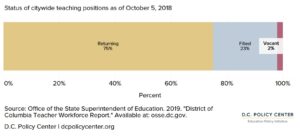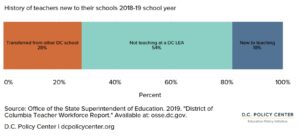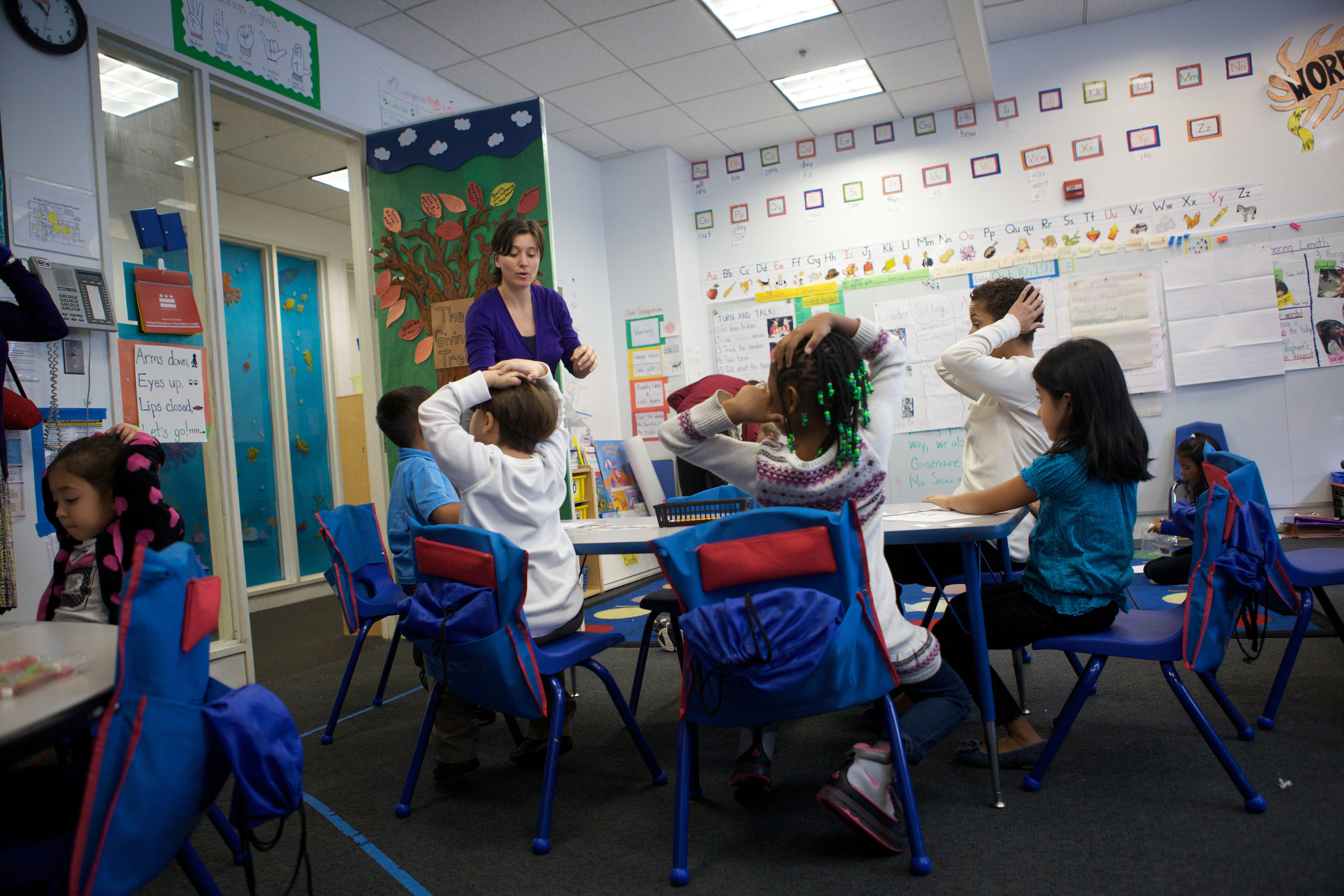Teacher quality is the most influential school-level contributor to student achievement,[i] which means retaining effective teachers is an essential component of improving student learning. Amid the challenges of distance learning during COVID-19, retaining teachers might also provide students with much-needed stability as teachers can build on their pre-existing relationships with students to provide support and teach more effectively.
The average annual teacher turnover rate across D.C. public schools and public charter schools is and has consistently been about 25 percent – compared to a national average of 16 percent. According to the State Board of Education’s study on teacher attrition, teachers who voluntarily resign or quit cite heavy workloads and a lack of professional support for teacher safety and mental health as two major factors leading to their departures.[ii]
Widespread school closures necessitated by COVID-19 may exacerbate these same issues for some teachers: workloads have shifted to accommodate distance learning, and more people are experiencing mental health issues at a time when mental health resources are difficult to deploy. These changes could lead to an increase in resignation rates, especially among older teachers who were already planning to retire in the next few years. On the other hand, some teachers may be less likely to leave current roles given high levels of unemployment – between March 13 and April 28, 81,942 new unemployment claims were filed in D.C.
Recruitment is another piece of the puzzle that has become more challenging given our current pandemic circumstances. Between the end of the 2017-18 school year and the beginning of the 2018-19 school year, 1,730 teaching positions needed to be filled. By October 5, only 2 percent of these positions remained vacant, suggesting that although D.C. experiences high teacher turnover, schools were able to find the talent they needed.[iii]


However, COVID-19 has introduced several obstacles to the traditional recruitment process, the greatest being that schools are unable to meet with candidates in-person. As a result, most school leaders are learning to navigate a virtual recruitment cycle for the first time. They’re experimenting with video conferencing, virtual school tours, and other online platforms to introduce themselves to candidates and gauge whether those candidates would be good fits.[iv] Organizations in D.C. are also working together to host virtual teacher recruitment fairs that give teachers and schools a chance to connect.[v] These efforts are important and will hopefully prove effective, but it’s important to note that for the 2018-19 school year, more than half of new hires were not teaching at a D.C. LEA the year prior, which means they either came from a private school, were on leave from teaching, or came from a school outside the District. This might make it much more difficult to recruit the necessary number of teachers, since about half of our filled positions in 2018-19 consisted of teachers who weren’t already physically here.


School budgets introduce an additional layer of uncertainty. The Mayor has proposed a three percent increase to the per pupil funding amount in the FY21 education budget, but it’s tough to predict what impact COVID-19 will have on the FY22 education budget. Previous economic downturns and public health emergencies have had a lasting negative impact on our country’s teacher workforce. Between 2008 and 2010, our country lost more than 120,000 teaching positions, and although nearly a decade has passed since the end of the Great Recession, we still have fewer public school teachers today than we did in 2008.[vi] Another factor that could influence school budgets in the coming years is enrollment. If families decide to homeschool or move out of the city due to restricted access to amenities and higher rates of telework, the demand for teachers might decrease.
To learn more about how schools are approaching these issues, the D.C. Policy Center reached out to several stakeholders to ask the following question: How is teacher retention and recruitment different this year?
Lewis D. Ferebee, Ed.D., Chancellor of DC Public Schools
While we have made several changes in the ways that we do our talent work this year, DCPS remains committed to recruiting and retaining dynamic educators who insist on excellence and are passionate about honing their craft.
Ensuring we have excellent educators in every classroom remains a top priority for DC Public Schools. We’re proud that this school year:
- 76 percent of our teachers returned to the same school where they taught the previous school year, a nearly 8-point increase in retention from a decade ago.
- We saw schools across all wards retain more than 85 percent of their educators at their school.
- We retained more than 90 percent of our effective and highly effective teachers.
When Mayor Bowser declared a public health emergency in March, DCPS quickly shifted focus to ensuring we continue to partner with our educators to provide them the support and resources they need to thrive during this difficult time. During learning at home, we are staying connected with our educators every day, supporting them with resources to cope with stress and anxiety, and celebrating their tireless efforts to keep our students engaged. I am also thankful for opportunities that I’ve had to convene my Teacher Advisory Board and focus groups to hear directly from our educators on learning at home and develop policies for this pandemic and the future.
As we think about the future and how we want to grow as a district, we also pivoted to a 100 percent virtual recruitment and hiring strategy for the 2020-21 School Year, with a focus on relationship-based recruitment and cultivation. We contacted more than 1,400 candidates through direct outreach and provided application support. We also hosted a webinar focused on recruiting male educators of colors and participated in larger-scale virtual events led by EdWeek, Diversity in Ed, and EdFuel. To reach candidates online, we tripled the number of targeted advertisements and job postings to leverage virtual networks. We are also excited about our strategy to recruit more Latinx educators, which includes creating additional job postings with Latinx-affiliated organizations and launching a campaign in Puerto Rico to attract Latinx educators, particularly for our Dual Language programs.
At DCPS, we take pride in including school visits in our hiring process. Candidates typically have the opportunity to see a school, interact with current staff, interview with the hiring committee, and even facilitate a demonstration lesson with students. Since this critical component of our hiring process cannot happen this spring, our talent team has facilitated webinars and created resources to support school leaders leading a virtual hiring process. These covered topics such as how to facilitate a digital panel interview, how to execute virtual demonstration lessons without students, and how to cultivate candidates while working remotely. To date, nearly two-thirds of DCPS principals have participated in one of our virtual hiring webinars, and we look forward to hosting more in the future. Our talent team has also created turnkey resources for school leaders as they think about implementing virtual strategies for retaining staff.
While we have made several changes in the ways that we do our talent work this year, DCPS remains committed to recruiting and retaining dynamic educators who insist on excellence and are passionate about honing their craft. Through our virtual strategy, we have engaged and successfully welcomed hundreds of phenomenal educators into the DCPS family, with the goal of preparing of our students up for success.
Kelly Gleischman, Managing Partner at EdFuel
In the current climate, schools are now needing to make all recruitment and hiring efforts virtual, which has posed both challenges and opportunities.
Even before COVID-19, teacher hiring was a daunting challenge for schools seeking to hire diverse, high-quality talent and for candidates looking to find the right position. In the current climate, schools are now needing to make all recruitment and hiring efforts virtual, which has posed both challenges and opportunities.
Many of the steps schools typically take with respect to hiring have not shifted immensely (and are just as important, if not more so, than before). Defining a clear employee value proposition, making website and marketing materials pop with key messages, creating an equitable and transparent hiring process, aligning internally on ownership, and tracking data ongoing are all critical to ensuring schools have a diverse, high-quality pipeline and ultimately staff.
But on top of these steps, which in normal circumstances take quite a bit of time and intentionality, schools are also needing to navigate new challenges. Assessing teacher effectiveness through sample teaches is one of those areas. While certainly challenging, schools have become incredibly innovative about how to assess quality, including conducting sample teaches through Zoom with students on the call, requesting videos of prior lessons, or allowing candidates to record themselves teaching virtually from home.
Schools are also having to figure out how to show candidates what it feels like to be part of their school community given that in-person building tours are no longer possible. Again, schools are responding in creative ways: updating websites with video footage of students and teachers, having staff members post video messages on social media channels, taking candidates on virtual tours of Zoom classrooms, and more.
Now more than ever, our students need strong teachers to guide them through this uncertain and difficult period. We have seen schools already rise to the occasion, and our hope is that the broader education ecosystem continues to support them in the ways that they need.
Adele Fabrikant, Executive Director at Teach For America D.C. Region
Two key factors affecting teacher retention and recruitment this year are school leadership and the economy.
All schools have been deeply impacted by the transition to distance learning during COVID-19 school closures. Among other changes, they’ve had to navigate how to best support their current staff while virtually recruiting and hiring new teachers. Prioritizing the education community, including retaining and hiring teachers, is essential in this moment. Two key factors affecting teacher retention and recruitment this year are school leadership and the economy.
In any year, teacher retention is closely linked to the expectations and guidance for teachers that are set by district leaders and tailored by principals to meet individual school needs. As a result, I believe teachers are paying close attention during this pandemic to how leaders are being responsive to students, families, staff, and district residents as they figure out important questions of how to teach and engage students remotely; balance home and work; hold teachers accountable; and support constituents effectively, among other concerns. Teachers who are seeing their leaders juggle these challenges with empathy, learning, an equity orientation, vulnerability, and effective prioritization may be more motivated to stay than those who are experiencing the opposite. In regard to hiring, a district’s ability to stay nimble and be clear in its decision-making process will determine how well and how quickly they can support schools in filling their teaching vacancies. At Teach For America D.C. Region, we believe that it is more important than ever to prioritize those who will be most impacted by our decisions – educators, students, and their families. Having a clear, responsive vision along with strategic action is at the core of strong school leadership.
The economy also significantly impacts both hiring and retention of teachers. It is hard to predict exactly how retention will be affected by the shifting economy, but given what we’ve seen at Teach For America D.C. Region, we would not be surprised to see a simultaneous exodus and influx of teachers in roughly the same proportions. Many teachers who call D.C. or bordering communities home may now have compounded commitments such as additional caregiver responsibilities and household expenses that would make it financially difficult to live in a region known for its high cost of living. These teachers might choose to leave the District. On the other hand, teachers looking for jobs in a struggling economy might move to the District if they found attractive opportunities.
As districts consider hiring, they are also grappling with the potential for central budget reductions, and examining how this in turn, will impact schools. We expect to learn more about the size of the teaching force as budgets are released for the next fiscal year. Currently, we support actions that do not lead to a reduction in force. We believe such reductions could potentially threaten the district’s ability to meet Every Student Succeeds Act (ESSA) regulations and its ability to improve learning outcomes for our most vulnerable students, among other expectations.
Caitlin Earle, Teacher at Paul PCS
One major worry I have going forward is that staff and student needs will increase when we return to school, but policy will be made without an awareness of what those needs are.
I can only speak from personal experience, and based on what I know, most teachers who were planning to leave this year made their decisions before the public health emergency began. I also think it’s unlikely that teachers will choose to leave their jobs during this time – unless the experience feels untenable for them. However, I do think the process of going back to school will be messy and could result in the loss of some teachers. Any disruption to the normal routine has consequences when you’re working with children. When we return to school, teachers are going to have to reset norms and retrain students on what it means to be prepared and engaged. We’re going to have rebuild school culture, and if teachers don’t receive the necessary support from schools, they’ll experience a lot of stress and might choose to leave despite the economic uncertainty.
In regards to recruitment, I think most of the hiring was in-process as early as February. We did have to adapt our recruitment process once we were no longer able to meet people in-person. I virtually interviewed several candidates to fill the position I’m vacating, and it was difficult to determine whether they’d be a good fit. Watching a teacher in the classroom tells you a lot about their style and how effective they are with students. Not being able to see that is a big loss. But we’ve tried to compensate for it by asking a lot of hypothetical questions. It’s not a perfect trade, but it’s helpful to hear candidates describe what their response might be to a particular scenario. We also ask candidates to submit a lesson plan and speak to their thought process in creating it, which is helpful.
One major worry I have going forward is that staff and student needs will increase when we return to school, but policy will be made without an awareness of what those needs are. I worry our funding will decrease and teachers will become more stressed and receive less support – I worry it’ll push some of them over the edge.
To read more about the impact of COVID-19 in the District of Columbia, click here.
Feature photo by US Department of Education (Source)
Chelsea Coffin is Director of the Education Policy Initiative at the D.C. Policy Center.
Tanaz Meghjani is an Education Analyst at the D.C. Policy Center.
Notes
[i] Hanushek, E. A., Kain, J. F., & Rivkin, S. G. (2005). Teachers, Schools, and Academic Achievement. Econometrica, Econometric Society, vol. 73(2), pages 417-458, 03.
[ii] Members of the State Board of Education. 2020. “Results from the 2020 D.C. Teacher Attrition Survey.” SBOE. Available at: https://sboe.dc.gov/sites/default/files/dc/sites/sboe/publication/attachments/2020-02-29-FINAL-2020%20Teacher%20Attrition%20Report%20%2B%20Cover%20Memo%20%2B%20Reply%20Letters.pdf
[iii] Office of the State Superintendent of Education. 2019. “District of Columbia Teacher Workforce Report.” OSSE. Available at: https://osse.dc.gov/sites/default/files/dc/sites/osse/publication/attachments/DC%20Educator%20Workforce%20Report%2010.2019.pdf
[iv] Heubeck, Elizabeth. 2020. “Coronavirus is pushing teacher hiring online. Here’s what that means.” Education Week. Available at: https://www.edweek.org/ew/articles/2020/03/30/during-coronavirus-crisis-districts-that-hire-teachers.html
[v] EdFuel. 2020. “DC Virtual Teacher Recruitment Fair.” EdFuel. Available at: http://www.edfuel.org/dcfair/
[vi] Griffith, Michael. 2020. “Learning in the Time of COVID-19.” Learning Policy Institute. Available at: https://learningpolicyinstitute.org/blog/impact-covid-19-recession-teaching-positions
